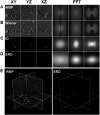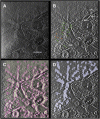Three-dimensional deconvolution processing for STEM cryotomography
- PMID: 33077585
- PMCID: PMC7959552
- DOI: 10.1073/pnas.2000700117
Three-dimensional deconvolution processing for STEM cryotomography
Abstract
The complex environment of biological cells and tissues has motivated development of three-dimensional (3D) imaging in both light and electron microscopies. To this end, one of the primary tools in fluorescence microscopy is that of computational deconvolution. Wide-field fluorescence images are often corrupted by haze due to out-of-focus light, i.e., to cross-talk between different object planes as represented in the 3D image. Using prior understanding of the image formation mechanism, it is possible to suppress the cross-talk and reassign the unfocused light to its proper source post facto. Electron tomography based on tilted projections also exhibits a cross-talk between distant planes due to the discrete angular sampling and limited tilt range. By use of a suitably synthesized 3D point spread function, we show here that deconvolution leads to similar improvements in volume data reconstructed from cryoscanning transmission electron tomography (CSTET), namely a dramatic in-plane noise reduction and improved representation of features in the axial dimension. Contrast enhancement is demonstrated first with colloidal gold particles and then in representative cryotomograms of intact cells. Deconvolution of CSTET data collected from the periphery of an intact nucleus revealed partially condensed, extended structures in interphase chromatin.
Keywords: chromatin; cryoelectron microscopy; tomography.
Conflict of interest statement
The authors declare no competing interest.
Figures






References
-
- Villa E., Schaffer M., Plitzko J. M., Baumeister W., Opening windows into the cell: Focused-ion-beam milling for cryo-electron tomography. Curr. Opin. Struct. Biol. 23, 771–777 (2013). - PubMed
-
- Elbaum M., Expanding horizons of cryo-tomography to larger volumes. Curr. Opin. Microbiol. 43, 155–161 (2018). - PubMed
-
- Frank J., Electron Tomography: Methods for Three-Dimensional Visualization of Structures in the Cell, (Springer Science & Business Media, 2008).
-
- Friedrich H., de Jongh P. E., Verkleij A. J., de Jong K. P., Electron tomography for heterogeneous catalysts and related nanostructured materials. Chem. Rev. 109, 1613–1629 (2009). - PubMed

